ミサイル駆逐艦
| アイコン | 意味 |
| 戦闘や事故で失った場合(沈没、墜落)や損傷した場合、艦船などの内部で事故や事件がおこった場合の意味です。自軍や同盟軍、所属機関、所有会社が行った沈没処分や破壊処分、漁礁としてまたは演習で使用して沈めた場合にはこのアイコンは付けません | |
| 戦果や功績、各機関に寄贈された場合の意味です。戦争などで沈没し、何十年後に発見された場合もこのアイコンです | |
| 映画やTVドラマ、ドキュメンタリーに使用された場合の意味です | |
| 参考文献、小説や書籍に登場する事柄です | |
| インターネットやTVゲームに登場する事柄です | |
| 不可解な事故&事件およびUFOなど超常現象に遭遇した事柄です |
- ※PSAは試験航海後の有用性(Post Shakedown Availability)の略
- ※データは駆逐艦ギアリング級の項を参照
- ※兵装はテリアSAM連装発射機1基、38口径127mm連装両用砲2基、50口径76mm連装両用砲2基(のちに撤去)、12.7mm単装機銃4基
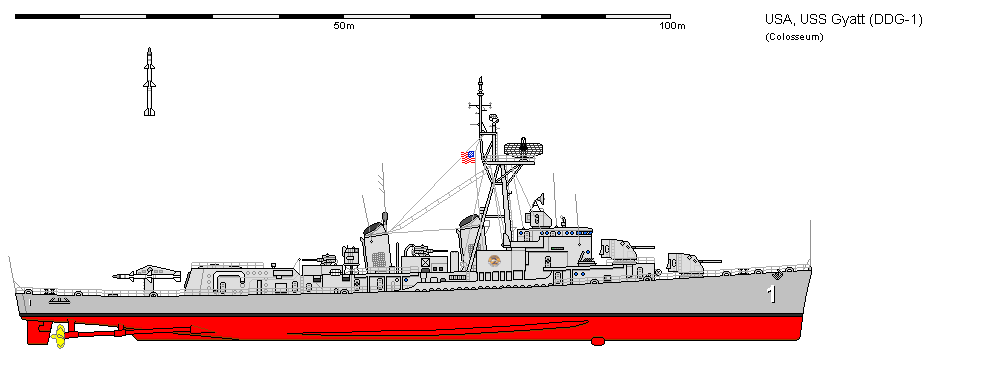
| 艦名 | NAME | 艦種記号 | 建造所 | 就役日 | 退役日 | 除籍日 | 備考 |
| ジャイアット (1、2) |
Gyatt | DDG-1 | フェデラル・シップビルディング&ドライ・ドック社 | 1945/7/2 | 1969/10/22 | 1969/10/22 | ◎1955/12/1 艦種をミサイル駆逐艦(DDG-1)に改める ◎1955/12/3 再役 ◎1956/12/30 艦種記号をDDG-712に改める ◎1957/5/23 艦種記号をDDG-1に改める ◎1962/10/1 艦種を駆逐艦(DD-712)に改める |
- ※データは駆逐艦フォレスト・シャーマン級の項を参照
- ※兵装:ターターSAM単装発射機1基、54口径127mm単装両用砲1基、アスロックSUM8連装発射機1基、324mm3連装短魚雷発射管2基
- ※1966年〜1967年に三脚檣をラティス・マストを換装
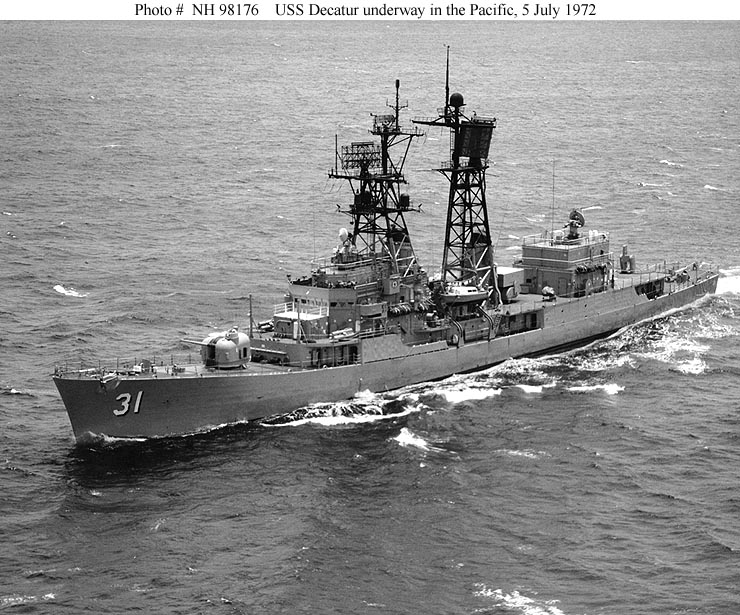
↑Image courtesy of Shipbucket.
| 艦名 | NAME | 艦種記号 | 建造所 | 就役日 | 退役日 | 除籍日 | 備考 |
| ディケイター (1、2) |
Decatur | DDG-31 | ベスレヘム・スチール社クインシー造船所 | 1956/12/7 | 1983/6/30 | 1988/3/16 | ◎1966/9/15 艦種をミサイル駆逐艦(DDG-31)に改める ◎1967/9下旬 PSA ◎1970/8末 オーヴァーホール(〜1971春) ◎1975春 ロング・ビーチ海軍造船所にてオーヴァーホール(〜1975夏) ◎1979/4上旬 オーヴァーホール ◎除籍後、自衛テスト艦(Self Defense Test Ship)に改装、艦種を実験ミサイル駆逐艦(EDDG-31)に改め、運用開始 |
| ◎Vietnam Aug 1968-Jan 1969, Mar-Jul 1970, Nov 1971-Feb 1972, Feb-Mar 1973, Korea Dec 1968, Iran/Indian Ocean Jan-Mar 1979. | |||||||
| ジョン・ポール・ジョーンズ | John Paul Jones | DDG-32 | バス鉄工所 | 1956/4/5 | 1982/12/15 | 1986/4/30 | ◎1967/3/15 艦種をミサイル駆逐艦(DDG-32)に改める ◎1967秋 再役 ◎2001/1/31 カリフォルニア沖にて標的として沈没 |
| パーソンズ | Parsons | DDG-33 | インガルス造船所 | 1959/10/29 | 1982/11/19 | 1984/12/1 | ◎1967/3/15 艦種をミサイル駆逐艦(DDG-33)に改める ◎1967/11/3 再役 ◎1989/4/25 標的として沈没 |
| サマーズ | Somers | DDG-34 | バス鉄工所 | 1959/4/3 | 1984/5/15 | 1988/4/26 | ◎1967/3/15 艦種をミサイル駆逐艦(DDG-34)に改める ◎1968/2/10 再役 ◎1998/7/22 標的として沈没 |
- ※データは嚮導駆逐艦ミッチャー級の項を参照
- ※兵装:ターターSAM単装発射機1基、54口径127mm単装両用砲2基、アスロックSUM8連装発射機1基、324mm3連装短魚雷発射管2基
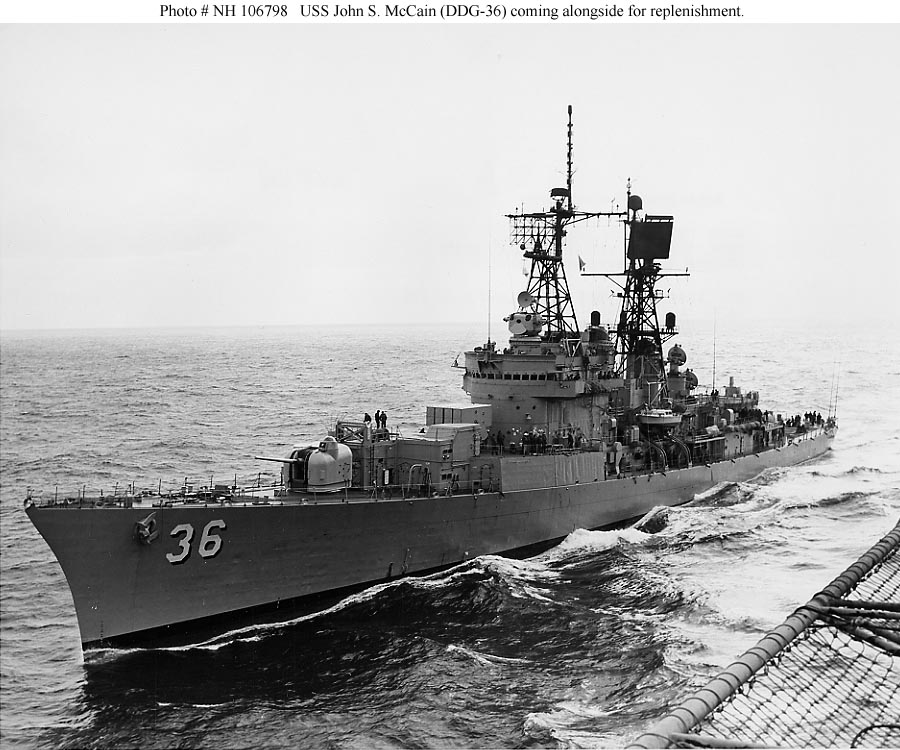
| 艦名 | NAME | 艦種記号 | 建造所 | 就役日 | 退役日 | 除籍日 | 備考 |
| ミッチャー | Mitscher | DDG-35 | バス鉄工所 | 1953/5/15 (1953/5/16?) |
1978/6/1 | 1978/6/1 | ◎1967/3/15 艦種をミサイル駆逐艦(DDG-35)に改める ◎1968/6/29 再役、フィラデルフィア海軍造船所にて艤装 ◎1980/8/1 解体のため売却 |
| ジョン S. マケイン | John S. McCain | DDG-36 | バス鉄工所 | 1953/10/12 | 1978/4/29 | 1978/4/29 | ◎1967/3/15 艦種をミサイル駆逐艦(DDG-36)に改める ◎1969/9/6 再役 ◎1979/12/13 解体のため売却 |
| ◎Vietnam Apr-May 1971, Apr-Oct 1972. | |||||||
| ウィリス A. リー | Willis A. Lee | DDG-37 | ベスレヘム・スチール社クインシー造船所 | 1954/9/28 (1954/10/5?) |
1969/12/20 | 1972/5/15 | ◎のちに艦種をミサイル駆逐艦(DDG-37)に改める予定がキャンセル |
| ウィルキンソン | Wilkinson | DDG-38 | ベスレヘム・スチール社クインシー造船所 | 1954/7/29 (1954/8/3?) |
1969/12/19 | 1974/5/1 | ◎のちに艦種をミサイル駆逐艦(DDG-38)に改める予定がキャンセル |
- ※データはミサイル・フリゲイトファラガット/クーンツ級の項を参照
- ※兵装:スタンダードER SAM連装発射機1基(1982年〜)、ハープーンSSM4連装発射機2基(1975年〜)、54口径127mm単装両用砲1基、324mm3連装短魚雷発射管2基
| 艦名 | NAME | 艦種記号 | 建造所 | 就役日 | 退役日 | 除籍日 | 備考 |
| ファラガット (1、2) |
Farragut | DDG-37 | ベスレヘム・スチール社クインシー造船所 | 1960/12/10 | 1989/10/31 | 1992/11/20 | ◎1975/6/30 艦種をミサイル駆逐艦(DDG-37)に改める ◎除籍後、BrownsvilleのNR Aquisitions/Sigma recycling Corp. にて解体(1、2、3、4) |
| ◎Iran/Indian Ocean Nov 1980-Jan 1981, Lebanon Dec 1982-May 1983, Libya Mar-Jun 1986. | |||||||
| ルース (1、2) |
Luce | DDG-38 | ベスレヘム・スチール社クインシー造船所 | 1961/5/20 | 1991/4/1 | 1992/11/20 | ◎1975/6/30 艦種をミサイル駆逐艦(DDG-38)に改める ◎のちにフィラデルフィアにてNaval Inactive Ship Maintenance Facility(NISMF)により保管(1、2、3、4、5) ◎2005/6/17 解体のため、フィラデルフィアのMetro Machine Corp. に売却 ◎のちにフィラデルフィアにて解体終了(1、2、3、4、5、6、7、8、9、10、11、12、13、14、15、16、17、18、19、20、21) |
| マクドノー (1、2) |
Macdonough | DDG-39 | ベスレヘム・スチール社クインシー造船所 | 1961/11/4 | 1992/10/23 | 1992/11/30 | ◎1975/6/30 艦種をミサイル駆逐艦(DDG-39)に改める ◎のちに解体のため、フィラデルフィアのMetro Machine Corp. に売却 ◎2003/10/21 フィラデルフィアのMetro Machine Corp. に引き渡される(1、2、3) ◎2004/9/10 解体終了 |
| ◎Iran/Indian Ocean Jul-Aug 1981, Aug 1982, Gulf War Oct 1990-Feb 1991. | |||||||
| クーンツ (1、2) |
Coontz | DDG-40 | ピュージェット・サウンド海軍造船所 | 1960/7/15 | 1989/10/4 | 1990/1/26 | ◎1975 ミサイル駆逐艦(DDG-40)となる |
| キング | King | DDG-41 | ピュージェット・サウンド海軍造船所 | 1960/11/17 | 1991/3/28 | 1992/11/20 | ◎1975 ミサイル駆逐艦(DDG-41)となる |
| マハン (1、2) |
Mahan | DDG-42 | メア・アイランド海軍造船所 | 1960/8/25 | 1993/6/15 | 1993/6/15 | ◎1975 ミサイル駆逐艦(DDG-42)となる |
| ダールグレン | Dahlgren | DDG-43 | フィラデルフィア海軍造船所 | 1961/4/8 | 1992/7/31 | 1992/11/20 | ◎1975 ミサイル駆逐艦(DDG-43)となる |
| ウィリアム V. プラット | William V. Pratt | DDG-44 | フィラデルフィア海軍造船所 | 1961/11/4 | 1991/9/30 | 1992/11/20 | ◎1975 ミサイル駆逐艦(DDG-44)となる |
| デューイ | Dewey | DDG-45 | バス鉄工所 | 1959/12/7 | 1990/8/31 | 1992/11/20 | ◎1975 ミサイル駆逐艦(DDG-45)となる |
| プレブル | Preble | DDG-46 | バス鉄工所 | 1960/5/9 | 1991/11/15 | 1992/11/20 | ◎1975 ミサイル駆逐艦(DDG-46)となる |
- ※1967年の案
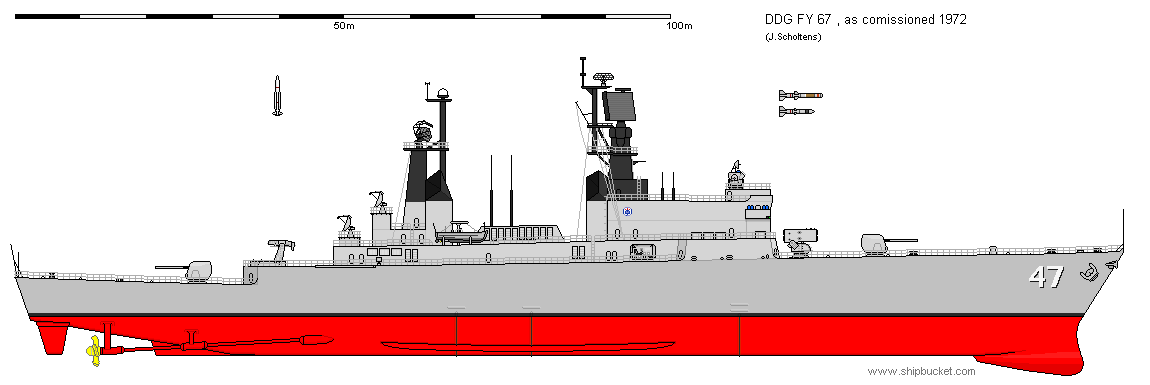
- ※データはミサイル巡洋艦タイコンデロガ級の項を参照
| 艦名 | NAME | 艦種記号 | 建造所 | 就役日 | 退役日 | 除籍日 | 備考 |
| タイコンデロガ | Ticonderoga | DDG-47 | インガルス造船所 | 1983/1/22 | 2004/9/30 | 2004/9/30 | ◎1980/1/1 艦種をミサイル巡洋艦(CG-47)に改める |
| ヨークタウン | Yorktown | DDG-48 | インガルス造船所 | 1984/7/4 | 2004/12/3 (2004/12/10?) |
2004/12/3 (2004/12/10?) |
◎1980/1/1 艦種をミサイル巡洋艦(CG-48)に改める |
| ヴィンセンズ | Vincennes | DDG-49 | インガルス造船所 | 1985/7/6 | 2005/6/29 | 2005/6/29 | ◎1980/1/1 艦種をミサイル巡洋艦(CG-49)に改める |
| ヴァリ・フォージ (1、2) |
Valley Forge | DDG-50 | インガルス造船所 | 1986/1/11 (1986/1/18?) |
2004/8/30 | 2004/8/30 | ◎1980/1/1 艦種をミサイル巡洋艦(CG-50)に改める |
- 軽荷排水量:6,210t 満載排水量:9,574t 全長:171.70m 幅:16.80m 吃水:6.20m(ソナー部10.00m) 主機/軸数:COGAG(ジェネラル・エレクトリック式LM2500ガス・タービン4基)/2軸 出力:80,000馬力 速力(計画):33.0kt 航続力(計画):20ktで6,000浬 兵装:ハープーンSSM4連装発射機2基、スタンダードMR SAM/アスロックSUM連装発射機2基、54口径127mm単装両用砲2基、76口径20mmCIWS2基、324mm3連装短魚雷発射管2基 搭載機:ヘリコプター2機 乗員:339名
- ※レーダー:SPS-64(V)9航海レーダー、SPS-55対水上捜索レーダー、SPS-48三次元対空レーダー、SPS-49(V)5回転式二次元対空レーダー、Mk. 86砲射撃指揮装置、Mk. 114水中発射指揮装置 ソナー:SQS-53A艦首ソナー 電子戦装置:レイセオン式SLQ-32(V)2統合電子戦装置
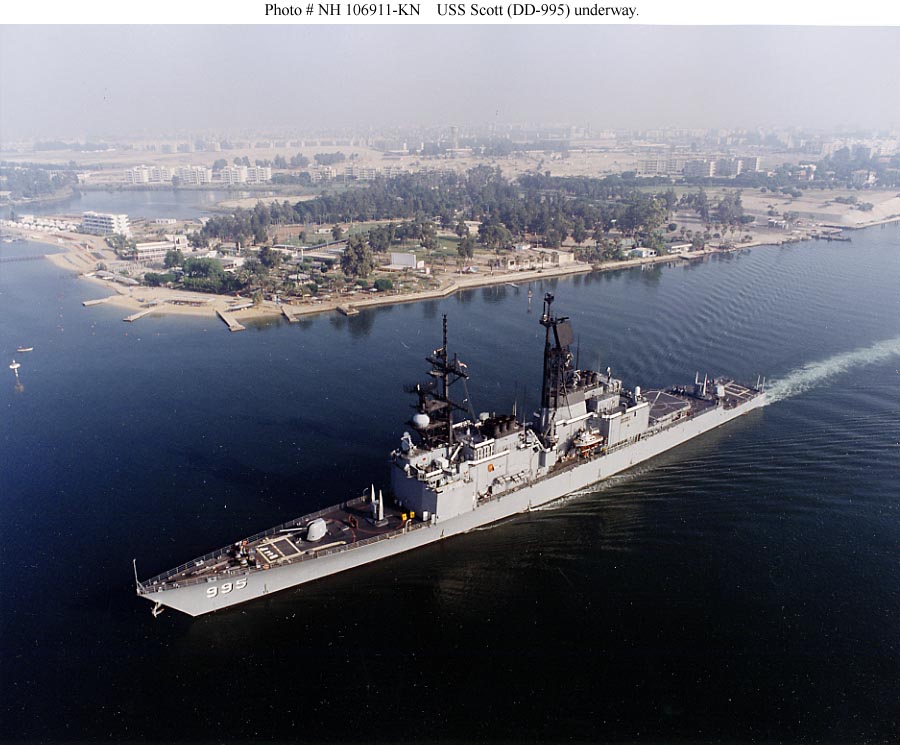

| 艦名 | NAME | 艦種記号 | 建造所 | 就役日 | 退役日 | 除籍日 | 備考 |
| キッド | Kidd | DDG-993 | インガルス造船所 | 1981/6/27 | 1998/3/12 | 1998/3/12 | ◎1979/8/8 ミサイル駆逐艦(DDG-993)となる ◎1998/3/12 ノーフォークにて保管(1、2、3、4) ◎台湾に売却するため、ノース・チャールストンのDetyens Shipyard社にてVSE社BAV事業部による改装 ◎2006/11/2 台湾に売却され左営 Tso-Ying(Tzuo-Ying?、DD-1803)と改名 |
| キャラハン | Callaghan | DDG-994 | インガルス造船所 | 1981/8/29 | 1998/3/31 | 1998/3/31 | ◎1979/8/8 ミサイル駆逐艦(DDG-994)となる ◎台湾に売却するため、ノース・チャールストンのDetyens Shipyard社にてVSE社BAV事業部による改装 ◎2005/12/17 台湾に売却され蘇澳 Su-Ao(DDG-1802)と改名 |
| スコット | Scott | DDG-995 | インガルス造船所 | 1981/10/24 | 1998/12/10 | 1998/12/10 | ◎1979/8/8 ミサイル駆逐艦(DDG-995)となる ◎台湾に売却するため、ノース・チャールストンのDetyens Shipyard社にてVSE社BAV事業部による改装 ◎2005/12/17 台湾に売却され基隆 Keelung(DDG-1801)と改名 |
| チャンドラー (1、2) |
Chandler | DDG-996 | インガルス造船所 | 1981/3/13 | 1999/9/23 | 1999/9/23 | ◎1979/8/8 ミサイル駆逐艦(DDG-996)となる ◎台湾に売却するため、ノース・チャールストンのDetyens Shipyard社にてVSE社BAV事業部による改装 ◎2006/11/2 台湾に売却され馬公 Ma-Kong(Ma-Kung?、DDG-1805)と改名 |
- ※イージス・システムを駆逐艦級の船体に載せる案は1971年末からあった。当時の海軍作戦部長のエルモ R. ズムウォルト Jr. 大将 Admiral Elmo Russell Zumwalt, Jr. が提案した仮称“DGイージス”は、防空任務のみで排水量は5,000t以内の簡素な艦で、単価$100,000,000以内とするもハイマン G. リッコーヴァー大将 Admiral Hyman G. Rickoverの筆頭とする核動力派の反発を食らう
.png)
.png)
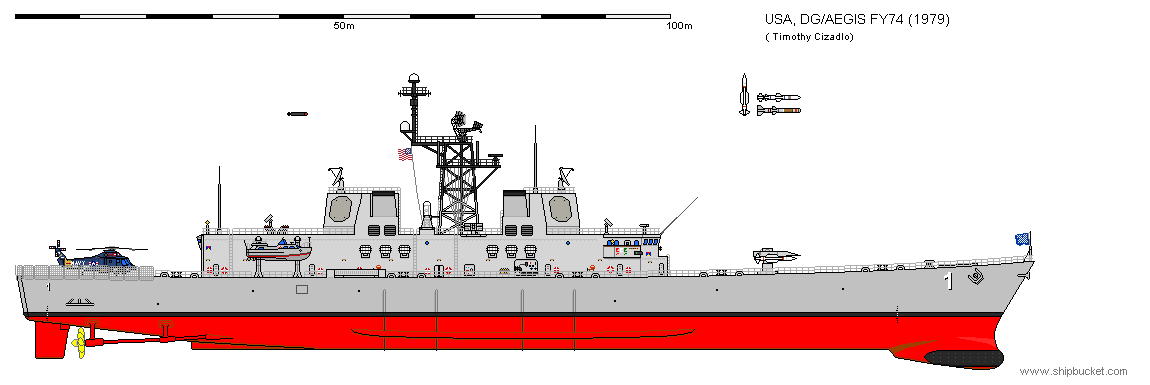
- ※1978年〜1982年にかけてDDX/DDGXと題した研究が海軍内で行われる。1979年には大きく5つのベースライン、細かく分ければ27の設計案が上がった。排水量7,000tでコスト$550,000,000の線でまとまりかけるもあちこち要求を聞いて修正する内に排水量9,100tにまで膨れ上がる。1982年末にはDDX/DDGX計画は、民間企業への仕様の提示と入札の段階まで達するもそこで海軍長官が突然入札を取り止める。そして1983年2月には海軍海洋システム・コマンド(Naval Sea Systems Command: NAVSEA)に対して部内で次期駆逐艦を設計するように指示が下される
- ※海軍の現在のアーレイ・バーク級ミサイル駆逐艦に続く、新世代の指向性エネルギー兵器と高出力センサーを推進するための力を提供するよう設計新しいSPY-6レーダーとベースライン10イージス戦闘システムを組み込んだアーレイ・バーク級フライトIIIの戦闘システムを使用してDDG(X)を開発中。この船は、従来のガス・タービン推進システムを、ズムウォルト級ミサイル駆逐艦に搭載されている統合パワー・システムのようなものに変更する予定。この新型艦は最大600kWのレーザーを供給し、敵の誘導ミサイルを妨害するのに十分な威力を発揮することができる。当初、この艦は上部構造の前方に32セルのMk. 41垂直発射システムを備えているが、海軍、陸軍、空軍のために開発されている国防総省の新しい極超音速兵器を搭載できる12の大型ミサイル・セルと交換することが可能。艦船のサイズとプログラムの推定コストは依然として不明である。新型軍艦計画は、新型アーレイ・バーク級の建造費用やコンステレーション級ミサイル・フリゲイトの開発費用を考えると、1隻あたり$1,000,000,000以上かかる。下の画像は海軍のDDG(X)船体設計の想定図
Update 25/01/17